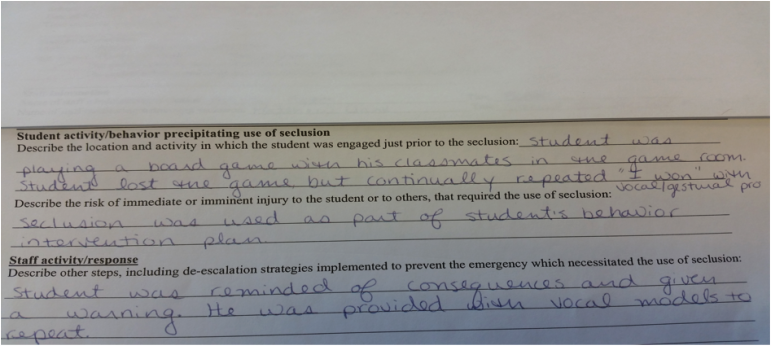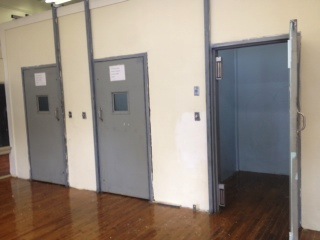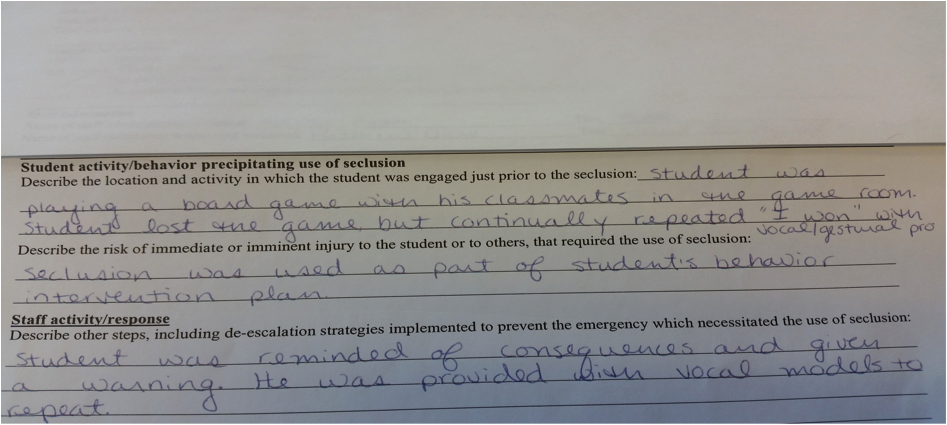A 4-year-old boy identified with a developmental delay was physically restrained by school staff after he “threw (puzzle) pieces on the floor and across the room” while playing with a puzzle on a classroom rug.
An elementary school student was put into seclusion after “swinging her coat at staff.”
These are among hundreds of incidents — deemed “emergencies” by school personnel — that warranted restraining and isolating pre-school and elementary school students in Connecticut last year. A new report by the state Office of the Child Advocate (OCA) raises “significant concern” regarding the frequency with which young children with autism and other disabilities are restrained or secluded; lapses in documentation or actual compliance with state laws; and the prevalence of “unidentified and unmet educational needs for children subject to forceful or isolative measures.”

Office of the Child Advocate
A report in a student file
The OCA report, released Wednesday, reviewed records of restraints and seclusions for 70 students at seven public schools and special education programs around the state, including Hartford and Fairfield County. Those students, chosen randomly, were restrained 1, 065 times and placed in seclusion 703 times. In a number of cases, the report found, there was no documentation showing that the children had received requisite behavioral evaluations, or that educators had monitored and reviewed cases of repeated seclusions, as required.
Underlying the findings is a larger concern that students subject to restraints and seclusion are not receiving adequate support — for example, intensive language, processing, sensory or cognitive interventions — for their social and behavioral problems.
“Restraint and seclusion are symptoms of a larger challenge – helping our providers, with training and resources, to find ways to meet the needs of children with special needs,” said state child advocate Sarah Eagan, who prepared the report in consultation with special education experts.
Under existing state law, children may be restrained only in emergencies, where they pose a risk of imminent harm to themselves or others. Seclusion—defined as confinement in a room, as opposed to a therapeutic “time-out” — may be used not only in emergencies but also as a planned intervention that is specified in a child’s educational plan.
In each of the last three years, the state Department of Education has reported about 30,000 incidents of restraints or seclusion, with autistic students the most frequently subjected to the practices. More than 1,300 children have been injured while restrained or isolated, some of them seriously. Research has shown that the techniques can be traumatizing to children, with no evidence that they have therapeutic value, the OCA report says.
The new review raises concerns that providers are broadly applying the “emergency” label, without documentation to back up that rationale or to show that they tried other interventions. It also found that, among children whose educational plans allowed seclusion, the technique was being used for minor incidents, without adequate reporting or review.
Among the cases cited in the report was a 9-year-old student with autism who was confined after he “refused to say ‘hello’” to a visitor who entered the classroom, and then “did so with vocal gestural protest.” In another case, a student who was playing a board game with his classmates was placed in seclusion after he “lost the game, but continually repeated ‘I won,’ with vocal/gestural protest.”
A fourth-grade boy diagnosed with autism was repeatedly placed in closed-door seclusion for “dysregulated” behavior, even though he engaged in suicidal gestures while in isolation. “Tied sock around neck” and “Threatening self: ‘I want to die’” are among the notes in his file.

Office of the Child Advocate
A room used for seclusion.
The report found wide inconsistencies in how schools and education programs handle restraint and seclusion. Even the spaces where children were secluded or confined varied widely – from padded rooms to storage and utility closets.
State and federal rules require that children whose behavior interferes with their ability to learn receive a formal behavioral assessment and intervention plan. But the report found no such records for 19 of the 70 children and inadequate records for others.
The review found that for many children with emotional or developmental disorders, educational plans lacked appropriate supports or services – leading to an “over-reliance” on restraint and seclusion. Part of the remedy is to offer teachers and administrators more training and resources to identify and address young children’s “social-emotional and functional communication development,” OCA said.
“Teachers, administrators, and related providers must have access to the tools they need to assist children at the youngest ages, provide guidance to families, and coordinate care with other agencies and community providers,” the report says.
The report comes two years after Connecticut formed an interagency task force focused on reducing restraint and seclusion. The state Department of Education compiles data from districts on the use of restraints and seclusion, but has “too few resources (though ample will) to investigate and monitor schools’ actual compliance with the law or best practices,” according to OCA.
The report makes 14 recommendations, which Eagan said she was assembling into a legislative proposal. In addition to requiring training for staff to reduce reliance on restraints and seclusion, the proposal calls for a statewide policy requiring any school district or program that uses restraints or seclusion to show evidence that it is using “evidence-based strategies for positive behavioral supports.”
The proposal also calls for: prohibiting the use of seclusion except for emergencies; banning the use of prone or face-down restraints and restricting the use of mechanical restraints; requiring a child’s education team to convene if a student has been restrained or secluded more than twice in a 30-day period; requiring school or program leadership to review restraint and seclusion data on a monthly basis; and establishing a special unit within the Department of Education, as well as a best practices committee, to monitor and reduce use of restraints and seclusion.
State education department spokeswoman Kelly Donnelly said Wednesday that education officials “share the Child Advocate’s concerns and would like to see the numbers reduced, as well.” She said the department “actively promotes and offers trainings on proven preventions and interventions to de-escalate behaviors before it reaches an emergency situation,” and is an active member of the interagency effort to reduce restraints and seclusion.
In a December report on seclusions and restraints in the 2013-14 school year, the state education department said it had provided professional development training to “multiple audiences” in regulations for using restraints and seclusion and interventions to reduce their use. The department also said it was using data to identify districts that needed additional guidance and training in positive behavioral interventions.

Office of the Child Advocate
Chart on seclusions and restraints compiled by the education department.
A total of 35,892 incidents of restraint or seclusion were reported by schools in 2013-14, an increase of 6.4 percent over 2012-13. Nearly 85 percent of the incidents were deemed “emergency” interventions, with a decline in the number of restraints and seclusions lasting more than five minutes. There were 370 injuries reported, nine of them serious – six during an emergency restraint and three during an emergency seclusion.
To read the full report click here.
